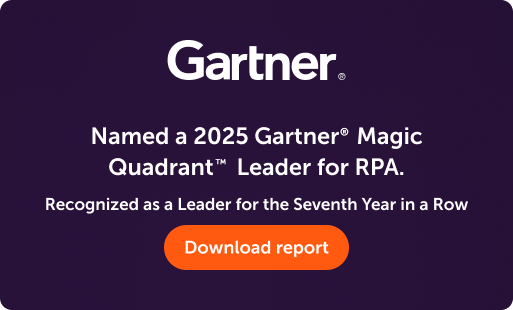- Login
- Search
- Contact Us
-
Have a question? Our team is here to help guide you on your automation journey.
-
Explore support plans designed to match your business requirements.
-
How can we help you?
-
- AI
AI Without the Hype From pilot to full deployment, our experts partner with you to ensure real, repeatable results. Get Started
- Automation Anywhere AI
-
- Solutions
Featured Agentic Solutions
Accounts Payable Invoice automation—No setup. No code. Just results. Accounts Payable
Customer Onboarding Scale KYC/AML workflows. Customer Onboarding
Customer Support Keep queues moving, even at peak load. Customer Support
Healthcare RCM Revenue cycle management that runs itself. Healthcare RCM
- Products
Platform Features
- Agentic process automation (APA)
- Robotic Process Automation (RPA)
- View all Products
-
- Resources
Get Community Edition: Start automating instantly with FREE access to full-featured automation with Cloud Community Edition.
Featured
 Named a 2025 Gartner® Magic Quadrant™ Leader for RPA.Recognized as a Leader for the Seventh Year in a Row Download report Download report
Named a 2025 Gartner® Magic Quadrant™ Leader for RPA.Recognized as a Leader for the Seventh Year in a Row Download report Download report- Become an Expert
- Developer Tools
- Get Support
- View all resources
-
- Partners
Find an Automation Anywhere Partner Explore our global network of trusted partners to support your Automation journey Find a Partner Find a Partner
- Find a Partner
- For Partners
-
Blog
Hype Vs. Reality: 4 Ways To Avoid the Trappings of AI Noise
The big question these days isn't if AI will impact your enterprise, but when and how profoundly. However, alongside AI's constantly expanding potential, we're witnessing an explosive surge in AI-related hype. Determining which is which — reality or hype — isn't easy.
Clearly, AI is already transforming industries and redefining competitive advantage at a dizzying pace. However, the surrounding whirlwind of press releases, massive funding rounds, and vaporware demands more than just awareness; it requires a clear, actionable strategy grounded in experience and expertise to harness AI's power without succumbing to fleeting trends. Otherwise, you'll find yourself struggling to separate the failed promises of self-driving vehicles and rocks on pizza from the proven AI-driven solutions for accounts payable, customer support, and revenue cycle management processes.
In this post, C-suite leaders will understand the critical steps to make sustainable, high-impact AI investments that drive real business value and secure your organization's future, all without falling into the hype trap.
AI imperatives for the C-suite
The velocity of AI advancement is undeniable. Accenture hails it as “the fastest-growing technology in our company's history," the UN forecasts that the global AI market will see a 25-fold increase in just a decade, and Grand View Research predicts a 35.9% CAGR for the global AI market over the next five years. For business leaders, this acceleration of technology creates immense pressure to act decisively. The challenge lies in distinguishing transformative opportunities from ephemeral hype.
Seasoned executives are right to be cynical. We’ve all witnessed the fallout from overhyped technologies and the resource drains of unproven trends. However, this AI cycle is profoundly different. Its impact and the pursuit of an autonomous enterprise are already proving significant and rapid.
Educating yourself on AI technologies helps you move quickly when it’s time to apply AI and automation. It’s also a good time to shift the organization’s view from the hype of AI as a cost-cutting and job-cutting tool to AI as a strategic driver of innovation, transformation, and growth that works collaboratively with humans.
Here are four practical ways to mute the AI noise so you can focus on using AI to generate strategic value.
#1 - Get back to basics
Regardless of your level or domain, CFO to marketing analyst, healthcare invoicing to IT executive, a great way to see through the hype is to start with a rigorous commitment to knowledge and practical experience.
- Deepen your understanding. Be a voracious reader, follow the experts, and dig into the details of the research with your internal teams. Gathering multiple perspectives helps you triangulate the truth versus the spin. Don’t be afraid to take a course, attend top AI industry conferences and discussions join online communities, too.
- Embrace agile experimentation. Gaining hands-on experience through trials, experimentation, and small-scale deployments provides real-world learnings that let you see how technologies can be applied today and what it’s like to work with different vendors. Today, small prototype projects might be things like IT helpdesk chatbots. This iterative approach allows you to identify and address challenges in a contained environment, mitigating risks before embarking on large-scale deployments.
- Define clear objectives. Remember to keep AI initiatives tethered to concrete business goals. While experimentation is crucial for learning, you’ll eventually need to aim AI deployments at the business. Articulate precise use cases and establish measurable KPIs for each project. Use progress toward those goals as justification for additional investments, and lack of progress to justify reassessments and cancellations in lieu of other options. This disciplined approach ensures AI investments are always aligned with strategic outcomes.
#2 - Keep an eye on the road ahead — and behind
Many stories have been written about legacy technologies that, when left to linger too long, hinder enterprise growth and agility. AI is no different; it demands a dynamic approach to technology lifecycle management.
Focus on strategic evolution, not revolution. Innovation is constant. New LLMs and approaches are emerging rapidly, but newer isn't always superior. A finely tuned, domain-specific LLM that delivered consistent results for months might be more reliable for a unique domain or niche application than the latest general-purpose model. Your AI maturity journey isn't a race to adopt every new tool, so think hard about which advancements genuinely enhance your organizational capabilities.
PwC’s advice is to “AI certifications, look back to look forward” with respect to AI: “Each decade [of industrial innovation] was marked by breakthroughs laying the groundwork for what came in subsequent decades.” This perspective highlights the importance of building for tomorrow by selectively integrating new AI capabilities as they become appropriate for your organization.
Your organization’s approach to AI maturity must also strike a balance between the need for speed, desired impact, and ability to invest. How much and how fast is up to you. The key point is to effectively match new AI advancements with specific organizational needs while considering the broader enterprise architecture.
#3 - Build a solid AI foundation now
Building a solid foundation for your AI future is an all-hands-on-deck proposition. Our “Capability Maturity Model for Collaborative Intelligence" provides a vital framework and roadmap for increasing readiness, expanding capabilities, and technological sophistication. This encompasses people, processes, technologies, data, trust, scalability, and governance.
- Data is the cornerstone. AI success relies on clean data to deliver accurate, trusted, complete, and consistent results. And in fact, AI can help with automated data validation to ensure data is of acceptable quality before it’s used by downstream AI applications. Using AI to gather data from incoming documents also accelerates data entry and removes slow, error-prone manual steps from the process.
- Governance provides the guardrails. The right AI platforms can enhance security, compliance, access controls, audit trails, and more, thereby creating a sustainable AI governance practice to support and guide ongoing AI scalability.
- AI fluency fuels the engine. You’ll want your teams to be reskilling and upskilling in parallel to your AI aspirations and deployments. External resources such as AI certifications, AI-focused professional community forums, and methodologies for implementing and scaling AI and automation all offer streamlined ways for teams to stay up-to-date on AI innovations.
Establishing these foundational elements now ensures you can experiment, expand, and scale AI when the time is right and with the flexibility to do so at your own pace.
#4 - Find a trusted AI partner
A recent CDW survey of IT leaders reveals a common paradox: Two-thirds of organizations say that their AI plans are solid, but AI execution is a struggle. The constant flux of AI breakthroughs and evolving solutions makes these investment and deployment decisions particularly challenging.
For CIOs and CFOs, being well-educated on AI is becoming a core competency, as mentioned. However, for departmental leaders across functions and industries — financial services, healthcare, human resources, and customer service — understanding the latest AI innovations is secondary to operational execution. Focus more on AI’s ability to help drive growth, speed up processes, and reduce waste, rather than the technology itself.
Regardless of your role, the AI landscape is moving faster than any single organization can typically track. Partnering with a trusted AI vendor offers a proven pathway to ensure your enterprise identifies and deploys the right AI solutions for maximum business benefit plus a faster time-to-value.
Seize your AI advantage
AI has transformational human and organizational potential. However, the imperative for executives is clear: Ignore the hype and, instead, take a strategic approach to AI grounded in practical, business-impacting applications.
By committing to agile experimentation, embracing continuous learning, building robust foundational capabilities, and forging trusted partnerships, enterprises can navigate the complexities of this rapidly evolving landscape. The goal is not merely to keep pace or stay on the cutting edge, but to proactively shape your organization’s AI-powered future, driving sustainable growth and delivering tangible business value to ensure your enterprise thrives in this new AI era.
About Automation Anywhere Staff
Get to know the Agentic Process Automation System.

For Students & Developers
Start automating instantly with FREE access to full-featured automation with Cloud Community Edition.



